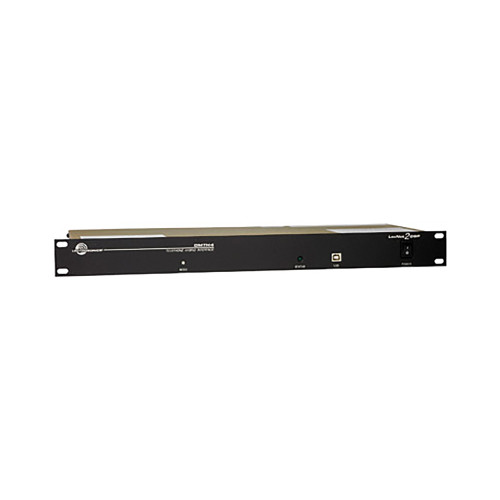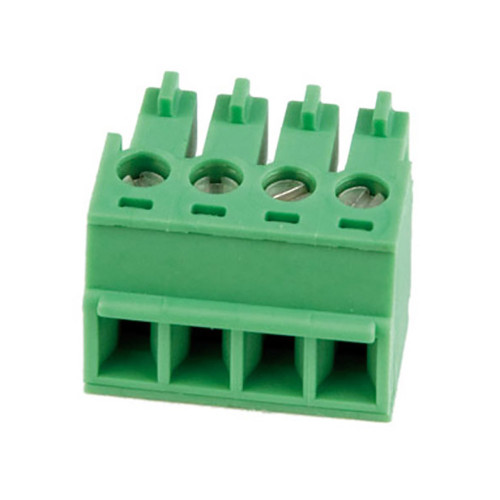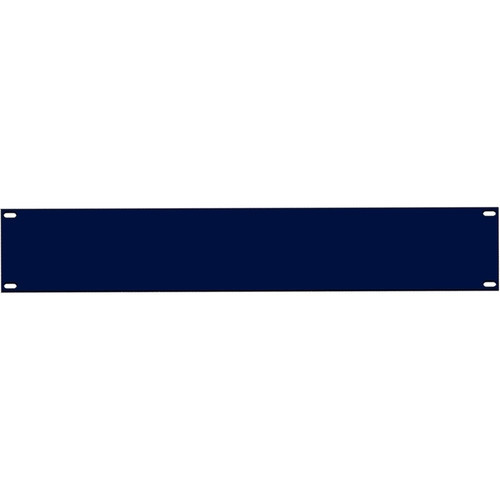Overview
The DMTH4 integrates telephone lines, video codecs and external audio sources into the digital bus structure of DM Series processors so these sources operate as though they are another microphone or audio input in the sound system. The unit is much more than just a telephone interface. Instead, it is a complete DM Series digital matrix processor, with a 3-in/24-out digital matrix, automatic mixing and comprehensive signal processing on every input and output. In essence, it simply connects to telephone lines, video codecs and external audio sources instead of mic/line inputs and outputs and integrates seamlessly with DM Series matrix processors.
The primary applications are in sound reinforcement and conferencing systems in boardrooms, courtrooms, worship centers, distance learning systems, hotels and other applications with multiple microphones and loudspeakers. The design represents a milestone in DSP technology in its basic architecture and in its processing speed and efficiency.
The challenge in teleconferencing using a sound system on one or both ends of a conference is to minimize echo heard at the far end caused by the coupling between loudspeakers and microphones in the local sound system. As sound from the far end enters the local sound system and is delivered by the loudspeakers in the local room, it will enter the local microphones and be sent back to the far-end. At the far-end the listeners will hear an echo of their own speech. The integration of adaptive gain proportional auto mixing* with an all new proprietary acoustic echo canceller provides a remarkable solution that is as easy to install and set up as it is effective. Echo-free teleconferencing and clean local sound reinforcement is provided even in poor acoustical environments.
The DMTH4 shares the large digital matrix bus with other DM Series processors to handle a wide range of sound system requirements from a modest boardroom to large systems with hundreds of inputs. Multiple units can be stacked with multiple DM processors to handle very large systems with multiple phone lines.
Extensive control capability is built into the unit with an intuitive command structure to allow external control with USB or RS-232 connections. Up to 128 macros can be stored in internal memory. Each macro can contain up to 64 commands, with 115 characters in each command. A built-in macro recorder greatly simplifies the creation of and use of macros.
Features
- 3-in/24-out digital matrix architecture
- Fully integrates with DM Series processors
- Telephone, codec and auxiliary inputs and outputs
- Two Acoustic Echo Cancellers - 126 ms tail time
- Line echo canceller - 30 ms tail time
- 6 filters plus compressor on each input
- 6 filters plus compressor/limiter on each output
- USB and RS-232 interfaces for setup and control
- Fully balanced audio signal flow through entire system - no pin 1 problem
- Digital I/O ports for "daisy chaining" and to connect other LecNet 2 devices
- Proportional gain auto mixing algorithm with AutoSkew™ - US Patent 5,414,776
- Simultaneous LecNet2 and Third-Party control
Specifications
| Echo Canceller (3 Total): |
2 Acoustic - 126 mS tail time
|
|
1 Line - 30 mS tail time
|
|
|
Will never diverge, regardless of signal type (i.e. sine wave)
|
|
|
Telephone Line Return Loss:
|
45 dB
|
|
Audio inputs (Codec, AUX):
|
|
|
Gain:
|
(-20 dB to +20 dB), programmable in 1 dB steps
|
|
Input impedance:
|
10 k Ohm
|
|
Connector:
|
5-pin Phoenix
|
|
Audio outputs (Codec, AUX):
|
Floating balanced, either side can be grounded
|
|
Nominal level:
|
0 dBu all outputs, -20 and -40 dBu selectable
|
|
Output impedance:
|
|
|
0 dB Attenuation:
|
• 450 Ohms differential
|
| (-20 dB) Attenuation: | • 50 Ohm differential |
| (-40 dB) Attenuation: | • 5 Ohm differential |
|
Input Dynamic Range (Codec, AUX):
|
102 dB (unweighted 20 - 20 kHz)
|
|
Output Dynamic Range (Codec, AUX):
|
105 dB (unweighted 20 - 20 kHz)
|
|
Audio Performance (Codec, AUX):
|
|
|
IMD + noise:
|
0.1% max.
|
|
0.02% nominal input level
|
|
|
THD + noise:
|
0.1% (worst case)
|
|
0.02% nominal input level
|
|
|
EIN:
|
-126 dBu
|
|
Connectors:
|
|
|
Audio I/O:
|
5-pin “Phoenix” type
|
|
Expansion:
|
RJ45
|
|
Logic I/O:
|
DB25
|
|
Serial:
|
Standard USB and mini TRS
|
|
Proprietary network
|
|
|
Physical level:
|
LVDS (Low Voltage DIfferential Signal) high speed
|
|
Connector:
|
Four RJ-45
|
|
Cable quality:
|
Shielded CAT-5
|
|
Transmission speed:
|
50 Mbits/s
|
|
Programmable control inputs
|
|
|
Number of inputs:
|
11
|
|
Analog voltage range:
|
0-5V
|
|
Logic input:
|
TTL, LVTTL, CMOS, LVCMOS
|
|
Programmable control outputs
|
|
|
Number of logic outputs:
|
8
|
|
Logic control:
|
active low
|
|
Max sink current:
|
100 mA
|
|
Max supply voltage:
|
40 V
|
|
Supply voltage for control I/O:
|
5 V |
|
Max current:
|
750 mA
|
|
Power requirements:
|
100-240 VAC, 47-63 Hz
|
|
Power consumption:
|
15 Watts (no ventilation requirements - no fan)
|
|
Dimensions:
|
|
|
Faceplate:
|
Standard 19 inch 1RU
|
|
Housing:
|
17.500” W x 1.710” H x 7.500” D
|
|
Weight:
|
1595 grams; 3.516 lbs. without AC cord
|









